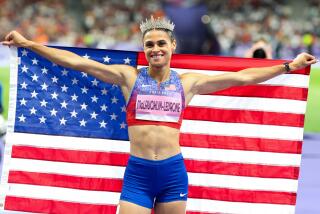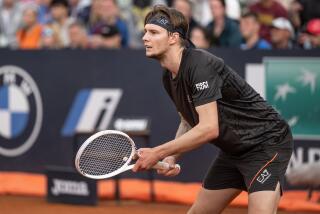A Case of Less Is More Popular?
- Share via
Tennis would do better in the television ratings and generally improve its popularity, Ivan Lendl believes, if the number of annual Grand Prix tennis tournaments were reduced from the current 65 to between 12 and 16.
Most of the sport’s top names play in no more than about 14 of the Grand Prix tournaments, the Czech player said while in Southern California last week as part of an adidas promotion for a new line of clothes bearing his name.
“The result is that the quality of most tournaments is diluted,” he said. “They may have only one top player or none. The Pro Council tries to get at least one of us to each place, but sometimes, it doesn’t work out.
“If we could take the 32 super series tournaments that are part of the Grand Prix and reduce them down to 12, then all the top players could play in every one,” Lendl said. “The interest would be much greater.” He said that perhaps 20 different cities could share the tournaments within each two- or three-year period.
Lendl, one of the top three male players in most world rankings, said ideally there should be one top tournament every month. Players below the top rank would play in lesser, so-called regular series tournaments, and, he suggested, there could be a system whereby those frequently winning those tournaments would be rotated into the Grand Prix super series, while players who did not do well in five consecutive top tournaments would be dropped down.
He also said that the present system of player rankings is too confusing and ought to be simplified.
“You’ve got the Grand Prix standings, the computer standings, the magazines and the individual experts,” he remarked. “You can’t blame the public for being up in the air as to who is best.”
As for television coverage of tennis, Lendl suggested that the American networks might consider adopting the Australian system, under which matches are aired with a time delay. That way, he said, the players can make their changeovers on their own schedule rather than waiting long enough to fit television commercials. Television, starting later, gradually catches up to game time.
Recently, he said, he has been cautioned repeatedly by television technicians to take the full minute or even more for his changeovers, and it has occasionally thrown him off stride.
Lendl’s agent, Jerry Solomon, an Angeleno who now works out of Washington, suggested several times during the interview that his player’s suggestions might have a hard time winning adoption.
But he indicated that he shares Lendl’s concern about building support for tennis. One bad sign, Solomon indicated, is the continuing slow decline in the number of racket, shoe and clothing companies willing to sign on as truly major sponsors of the sport.
Lendl said that he believes the tennis schedule has become too complicated. He said it takes six to eight months for a city to get approval for a tournament, and then some of the tournament promoters do not have the expertise to make it successful.
“This is a good time to cut back,” he said. Actually, cut back once again, since the number of Grand Prix tournaments has been as high as 90 a year.
Lendl said he plays in 14 Grand Prix tournaments each year. He makes many other appearances in exhibitions, as well as indoor and other special events.
The Czech player lives in this country just under half of each year, but he continues to make periodic visits to his parents back home and has an arrangement whereby 20% of all of his earnings of better than $1 million a year are paid in taxes to the Czechoslovak government. The arrangement is one of a slowly growing number whereby Eastern Bloc athletes are allowed to pursue their talents freely in the West.
More to Read
Go beyond the scoreboard
Get the latest on L.A.'s teams in the daily Sports Report newsletter.
You may occasionally receive promotional content from the Los Angeles Times.










